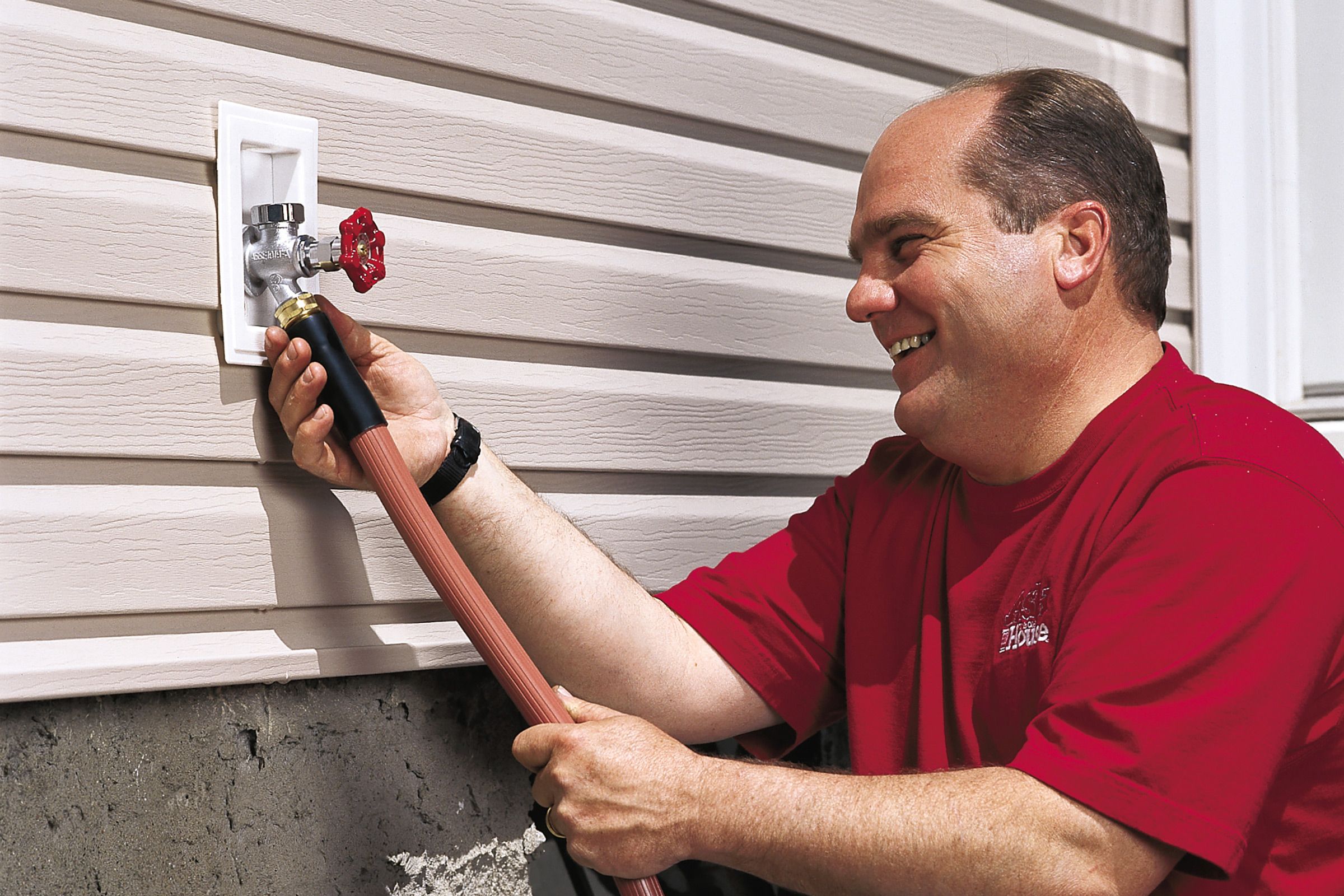Project details
Skill
Cost
Estimated Time
Even the most experienced DIYers shudder at the thought of a frozen or burst water pipe. If not immediately noticed, a ruptured pipe can be both expensive and time-consuming to clean up. Fortunately, the pipe that’s most susceptible to extremely cold weather—the outdoor hose faucet—is also one of the easiest to protect from freezing.
Specialized outdoor faucets are designed to withstand freezing temperatures, preventing burst pipes during cold winter months and potentially saving you from costly water damage and repairs.
In this guide, we’ll walk you through the entire installation process. By following these steps, you’ll be able to protect your home’s plumbing system and enjoy worry-free outdoor water access year-round.
How Does a Freezeproof Faucet Work?
Freezeproof faucets work by extending the pipe that connects to the water supply into the heated area of your home. When you turn off the faucet, water drains out of the long pipe, leaving no water to freeze near the outdoor opening. This design ensures that any remaining water is safely inside the warm house, preventing ice formation and potential pipe bursts.
Installing a freezeproof faucet offers several advantages, including the following:
- Prevents pipe bursts due to freezing
- Eliminates the need to shut off and drain outdoor faucets each winter
- Provides year-round access to outdoor water
- Reduces the risk of costly water damage repairs
- Potentially increases home value and efficiency
Types of Freezeproof Faucets
Freezeproof faucets come in several designs, and understanding the distinctions can help you choose the one that best fits your needs. These are the three main types of freezeproof faucets:
- Integral vacuum breaker faucets: These have built-in backflow prevention to make sure water does not contaminate your potable supply.
- Standard frost-free faucets: Simple and effective, these require the correct downward angle for efficient drainage.
- Wall hydrant-type faucets: These are suitable for areas that might face extreme temperatures, offering reinforced insulation.
Climate plays a major role in choosing the right freezeproof faucet. In milder climates, a standard frost-free faucet may suffice, while homes in regions with harsh winters might need wall hydrants with added insulation.
Preparing for a Freezeproof Faucet Installation
Proper preparation is key to a successful freezeproof faucet installation. Gathering the right tools and materials and taking the necessary safety precautions will help you achieve a smooth installation.
Tools and Materials Needed
To install a freezeproof faucet, you’ll need the following:
- Adjustable wrench
- Pipe cutter or hacksaw
- Soldering torch and lead-free solder (if you have copper pipes)
- Emery cloth or sandpaper
- Teflon tape
- Screwdriver
- Caulk and caulk gun
- Safety goggles
- Fire-resistant cloth or sheet metal
- Fire extinguisher
Safety Precautions
Depending on your home’s pipes, this project may involve soldering with a propane torch. Use extreme care when working with the flame: Wear eye goggles, protect combustible materials with a fire-resistant cloth or sheet metal, and keep a fire extinguisher nearby just in case.
Safety should be your top priority when working with plumbing and soldering. Other precautions include ensuring you have proper ventilation and shutting off the main water supply before starting work.
Removing the Old Faucet
The first step in installing a new freezeproof faucet is removing the existing one. This process involves shutting off the water supply, draining the faucet, and carefully removing it from the wall.
Tip: Don’t discard the old faucet just yet. You may be able to use the part of the supply pipe that’s attached to it to connect the new freezeproof faucet.
Step 1: Shut Off the Water Supply
Locate the shut-off valve closest to the hose faucet you’re replacing. Turn it clockwise to close the water supply. If you can’t find a nearby shut-off valve, you may need to turn off the main water supply to your home.
Step 2: Drain the Existing Faucet
After shutting off the water, go outside and open the faucet to drain any remaining water. If there’s a small drain cap on the shut-off valve, loosen it to release any trapped water between the valve and the faucet.
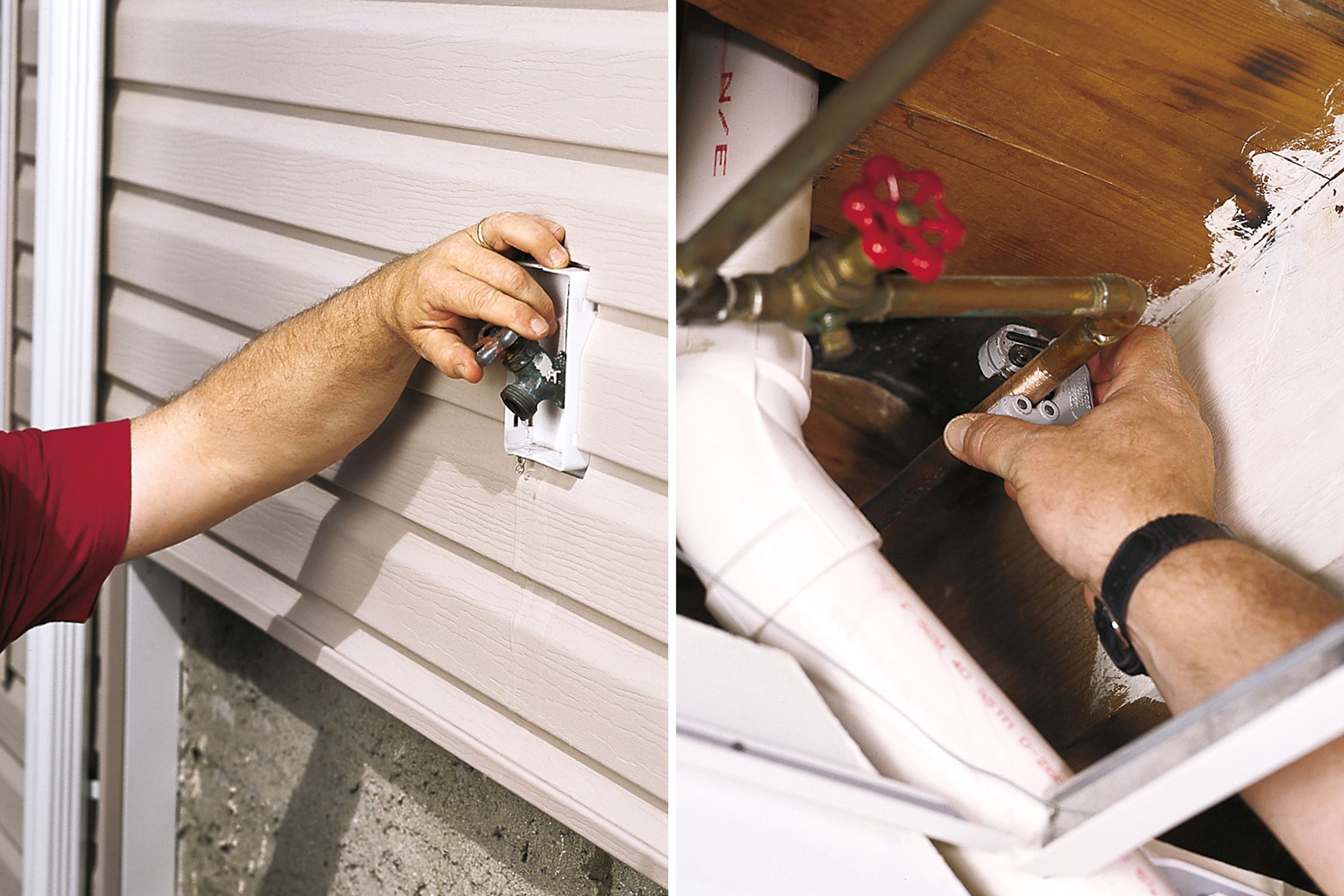
Step 3: Remove the Old Faucet from the Wall
Unscrew the screws holding the old faucet to the house. Carefully pull the faucet out of the wall. If the flange is stuck behind the siding or trim, use a pry bar to gently work it free.
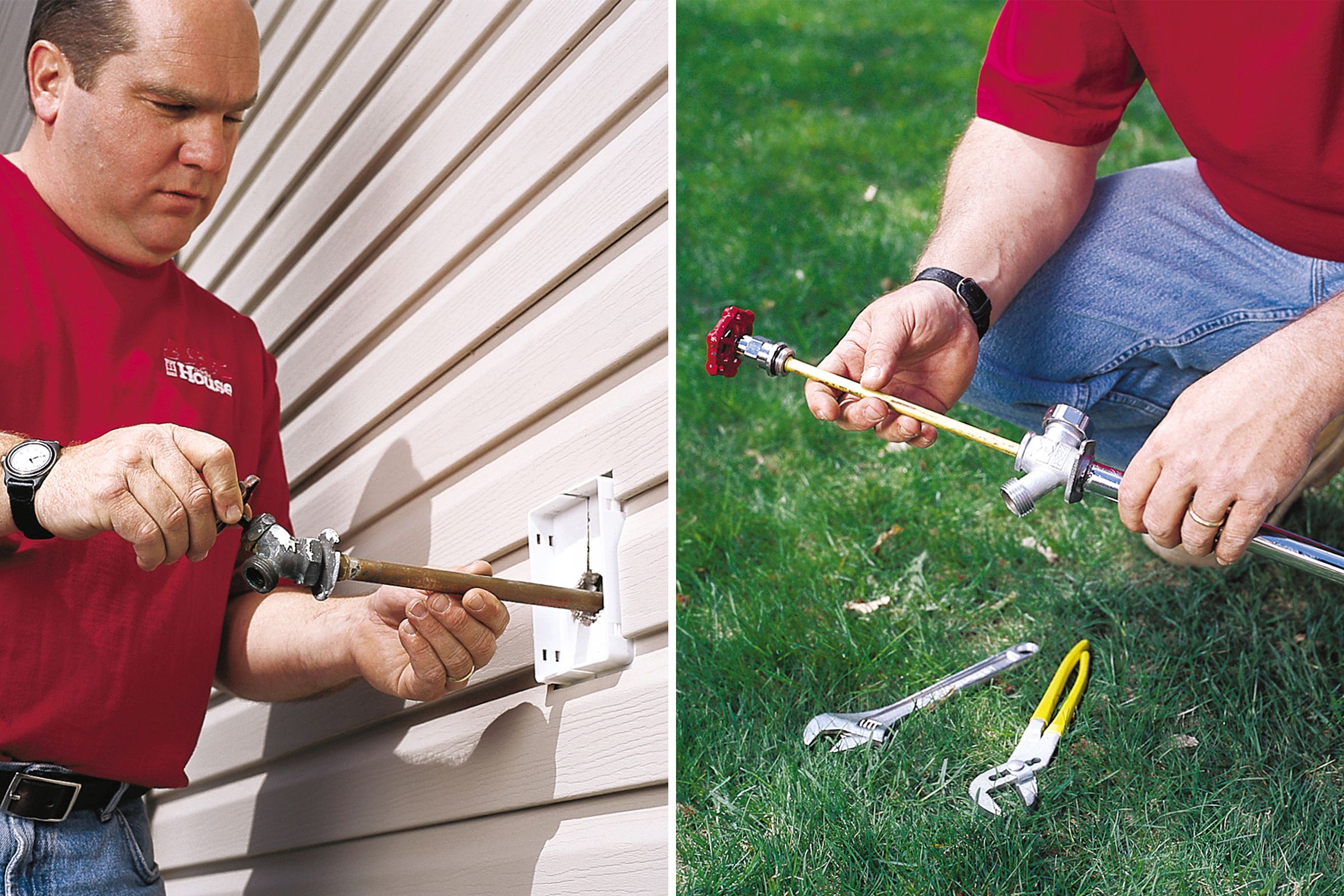
Installing the New Freezeproof Faucet
With the old faucet removed, you’re ready to install the new freezeproof model. This process involves measuring and cutting the supply line, inserting the new faucet, and connecting it to your home’s water supply.
Step 4: Measure and Cut the Supply Line
Inside the wall, locate the horizontal pipe coming from the old faucet. Measure where the new freezeproof faucet will reach, add 6 inches, and mark this spot. Clean the area with emery cloth or sandpaper if it’s a copper pipe. Use a pipe cutter or hacksaw to cut the pipe at your mark.
Step 5: Insert the New Faucet
Remove the stem assembly from the new freezeproof faucet to prevent damage during installation. Wrap the threaded end with Teflon tape and slide it through the hole in the wall. If the hole is too large, first apply a bead of adhesive caulk around the pipe to seal out cold air.
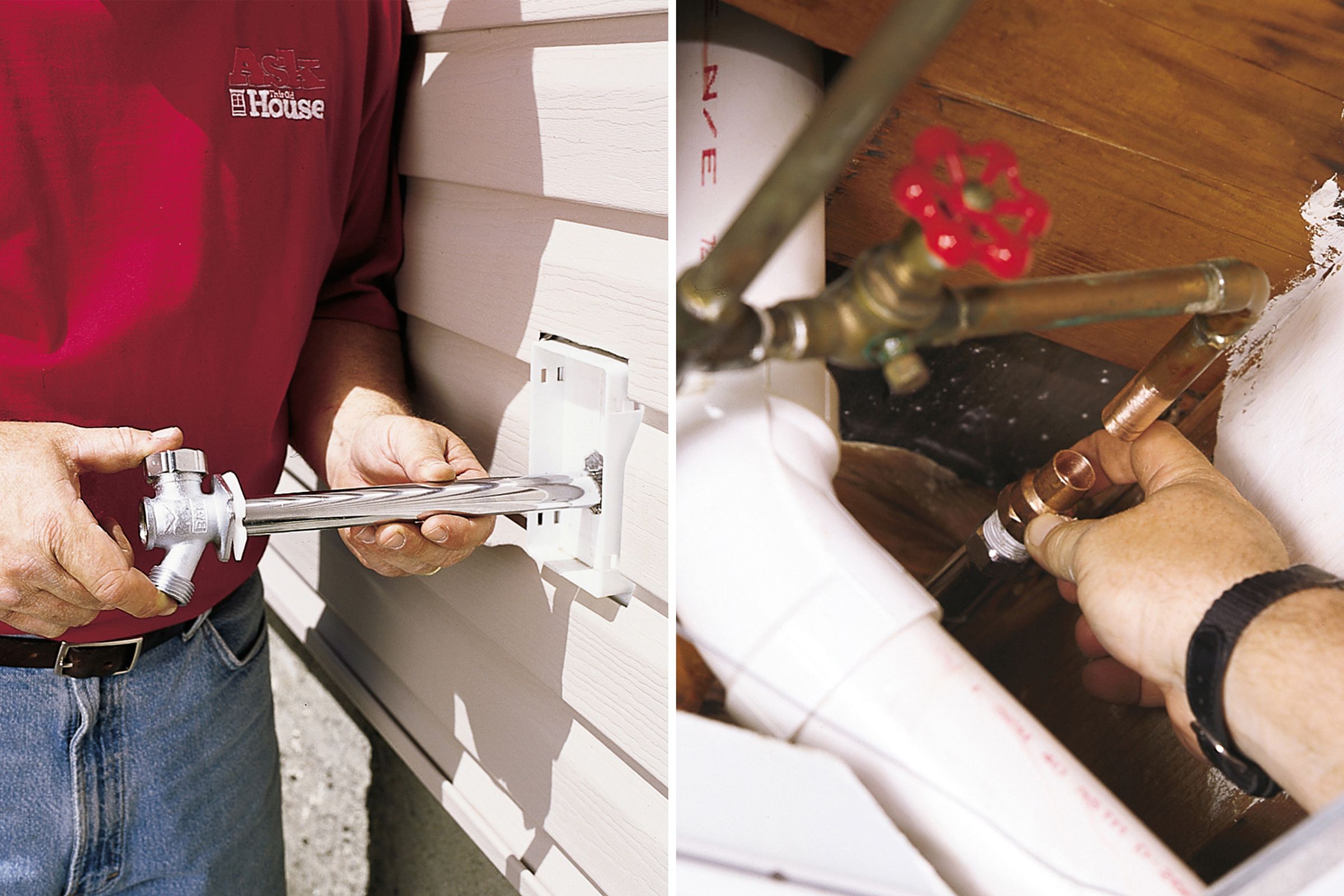
Step 6: Connect the Faucet to the Water Supply
Thread a 1/2-inch female copper adapter onto the end of the freezeproof faucet and tighten it with a wrench. Measure the gap between the adapter and the water supply pipe, add 1/2 inch, and cut a length of new pipe to fit.
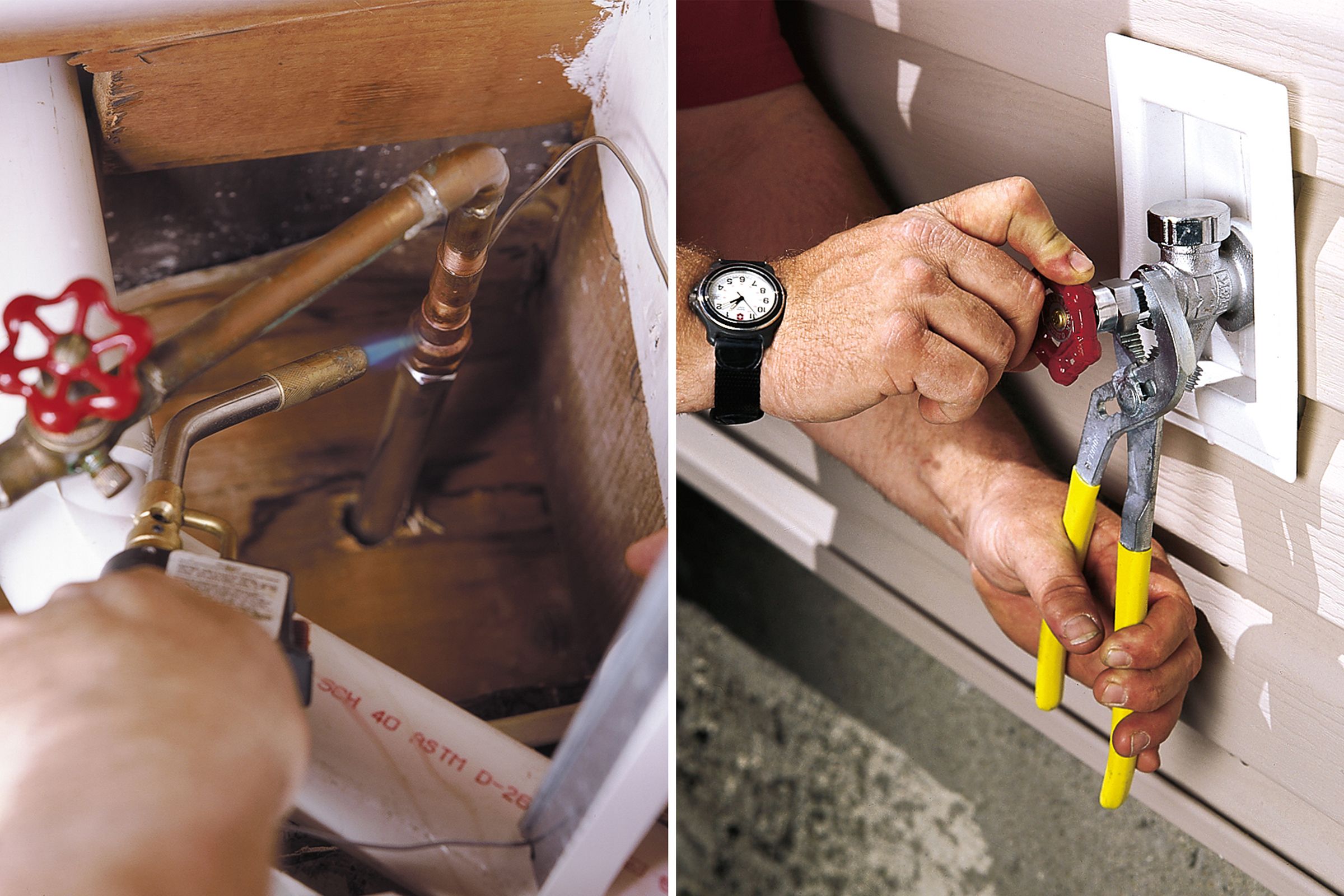
Soldering and Sealing the New Freezeproof Faucet
Proper soldering is important for creating a watertight seal and ensuring the longevity of your freezeproof faucet installation. You may be able to use a connector for some types of pipe, but copper pipes often require soldering.
Step 7: Prepare Pipes for Soldering
Clean all pipe ends and fittings with emery cloth and a wire fitting brush. Apply flux to all connecting surfaces before soldering. This preparation will help you achieve a strong, leak-free connection.
Step 8: Solder for a Watertight Seal
Slide a 1/2-inch coupling over the end of the water supply pipe. Insert the short pipe section into the coupling at one end and the adapter at the other. Use a propane torch to heat the joints and allow them to cool before handling.
Step 9: Insulate the Faucet and Pipes
For extra protection against freezing, wrap the faucet’s pipe with pre-slit foam or fiberglass pipe insulation tubes. This additional layer of insulation helps maintain a consistent temperature and further prevents freezing.
Testing and Troubleshooting With a Freezeproof Faucet
After installation, test your new freezeproof faucet and address any issues that may arise.
Check for Leaks
Close the drain nut on the shut-off valve and open the valve to restore water flow. Inspect all connections for leaks, paying close attention to the soldered joints and the faucet’s connection to the wall.
Ensure Proper Drainage
Turn on the new faucet and let the water run for a few seconds to flush out any excess flux. Then, turn off the faucet and confirm it drains properly. A freezeproof faucet should not hold water when turned off.
Common Issues and Solutions
If you encounter leaks, tighten connections or resolder joints as needed. For drainage issues, check that the faucet is installed at a slight downward angle to allow for proper water evacuation.
Maintaining Your Freezeproof Faucet
Regular maintenance will help your freezeproof faucet last longer and perform better. Here are a few tips you can follow to keep your freezeproof faucet operating correctly year after year:
- Inspect the faucet and surrounding area for signs of leaks or damage each spring and fall.
- Remove and store hoses before winter to prevent ice buildup.
- Check and replace worn washers or O-rings as needed.
- Lubricate moving parts annually with silicone-based grease.
When To Replace Your Freezeproof Faucet
While freezeproof faucets are durable, they may eventually need to be replaced. Signs it’s time for a new faucet include persistent leaks, visible corrosion, and difficulty turning the handle. Most freezeproof faucets last 15–20 years with proper care.
Professional vs. DIY Freezeproof Faucet Installation
While many homeowners opt to install freezeproof faucets themselves, it’s worth considering the pros and cons of professional installation. This section helps you decide whether to go DIY or hire an expert.
Benefits of Professional Installation
Hiring a professional plumber can save you time and ensure a high-quality installation. Pros bring experience and the right tools to handle unexpected issues so your faucet operates correctly and without leaks. Plus, many plumbers offer warranties on their work, providing peace of mind.
DIY Installation Challenges
DIY installation can be rewarding but comes with challenges. Soldering requires practice, and improper connections can lead to leaks. Additionally, working with your home’s water supply necessitates careful planning and execution. Be honest about your skill level and comfort with these tasks before proceeding.
Our Conclusion
Installing a freezeproof faucet is a smart investment for homeowners looking to protect their plumbing systems from winter damage. By following this step-by-step guide, you can successfully install a freezeproof faucet and enjoy the peace of mind that comes with year-round outdoor water access.
While this project is manageable for those with basic plumbing skills, it does involve soldering and working with your home’s water supply. If you’re unsure about any step of the process, don’t hesitate to consult a professional plumber. The cost of professional installation is often far less than the potential expense of repairing water damage from a burst pipe.
